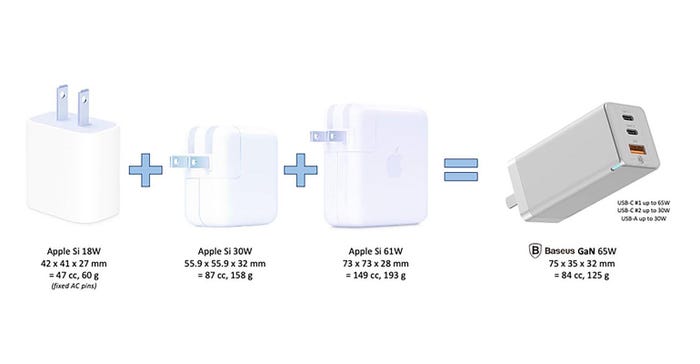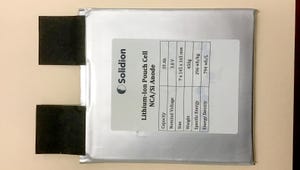
Gallium Nitride (GaN) is a semiconductor material distinguished by its remarkable electrical properties, a wide-bandgap, elevated electron mobility, and capacity to manage higher voltages and temperatures. GaN surpasses silicon material in various aspects, exhibiting faster switching speeds and better thermal conductivity. This results in creating devices that can accommodate higher carrier densities and achieve compact, densely packed structures.
With a keen focus on GaN technology, Navitas Semiconductor has been redefining the landscape of power solutions for automotive and smartphone applications. Navitas Semiconductor’s website states, “Navitas solutions can deliver 3× faster charging and 70% energy savings, enabling 5% longer range or 5% lower battery cost. The use of GaN materials, for example, could accelerate worldwide EV adoption by up to three years, and drive a 20% reduction in road-sector CO² emissions by 2050.” Let’s delve into the myriad advantages that GaN technology brings to the forefront of these industries, guided by Navitas Semiconductor CEO Gene Sheridan.
Mobility with GaN
How does using GaN material enable electric vehicles with extended driving range and power density?
Sheridan: GaN (gallium nitride) is a more advanced, higher-performance material than legacy silicon, so is faster switching and more efficient, allowing power systems to be three times smaller and lighter compared to legacy silicon systems.
Consequently, electric vehicles can either have smaller and lighter onboard chargers, leading to improved acceleration and range, or they can be charged three times faster for the same charger size and weight.
Are there any unique challenges or considerations when integrating GaN material into the design and production of lighter EV batteries, and how is Navitas Semiconductor addressing those challenges?
Sheridan: While GaN as a material is not used directly within EV batteries themselves, it plays a crucial role in processing power on the way to the battery. Navitas addresses the challenges of integrating GaN material by focusing on its application in charging systems. New battery technologies like Lithium-iron phosphate (LFP) or graphene lithium-ion are able to absorb power quickly while remaining cool, and with a long lifetime. GaN-based chargers are ready to provide as much power as the battery can handle.
Tesla recently announced that the team figured out a way to use 75% less silicon carbide (SiC) transistors without compromising the car’s performance or efficiency. How might this impact the competitive landscape between GaN and SiC in the electric vehicle sector? What is your vision for the future of GaN technology in the context of EV batteries?
Sheridan: The Tesla estimate is an ‘apples-to-oranges’ calculation, assuming as a baseline a five-year-old, high-power design, using SiC chips available at that time. The ‘new’ example is not yet in production, has a lower-power motor, and takes advantage of advances in SiC technology with higher performance and generational die-shrinks.
GaN and SiC are ‘wide bandgap’ (WBG) devices and have a very strong future in electric vehicles, offering higher performance and lower system costs. In fact, EVs are a dominant factor in WBG devices taking 30% of the legacy silicon market by the end of 2027. Navitas envisions GaN technology will accelerate the adoption of electric vehicles by enhancing range, charging speed, and overall efficiency.
Connectivity with GaN
Are there any specific advantages GaN offers over traditional charging technologies?
The increasing need for batteries with greater capacity and the desire for quicker charging times are propelling chargers towards higher power outputs, improved efficiency, and more compact designs. GaNFast power ICs are leading a transformative shift in rapid and ultra-fast charging across various mobile devices such as smartphones, tablets, and laptops.
Sheridan: For a traditional ‘wired’ charger, GaN offers three times faster charging in half the size and weight of legacy silicon solutions. Today’s ‘wireless’ chargers assume an up-stream AC-DC converter, followed by the wireless power transmission. GaN’s high-speed characteristics are well-suited to high-frequency wireless charging, enabling single-stage ‘AC-AC’ conversion, reducing component count, and enhancing efficiency.
Can you elaborate on the benefits of GaN power adapters for smartphones? How does GaN technology enhance the user experience?
Sheridan: GaN power adapters offer a range of advantages for smartphones, greatly enhancing the user experience. These benefits include significantly faster charging speeds, reduced form factors, and enhanced power conversion efficiency. Leveraging GaN technology enables power conversion to take place at higher switching frequencies, resulting in the creation of adapters that are up to three times smaller and lighter while still delivering rapid charging capabilities.
A notable example is the realme GT 3 smartphone, which can achieve a full charge in 9 minutes and 30 seconds when utilizing a 210W GaNFast adapter equipped with Navitas GaN Power ICs. This breakthrough technology not only revolutionizes charging speed but also introduces an unmatched level of portability and convenience to the mobile market. The combination of faster charging and smaller, more compact adapters ensures that users can swiftly power up their smartphones without compromising on efficiency or reliability.

How does GaN technology enable smartphone manufacturers to design sleeker, more compact wireless charging pads and power adapters?
Sheridan: GaN technology empowers smartphone manufacturers to design compact wireless charging pads and power adapters without compromising on power output or reliability. Navitas Semiconductor’s GaN power ICs have a strong track record of quality and reliability, backed by a 20-year limited warranty, setting a new standard in the industry. These integrated circuits enable additional features like lossless current sensing and autonomous protection, enhancing overall system reliability. As cell phone battery technology advances, GaN power ICs can deliver maximum power and fast charging in line with evolving specifications.
About the Author(s)
You May Also Like





